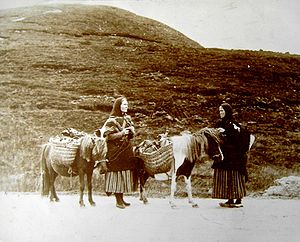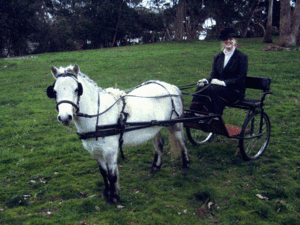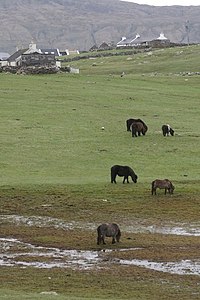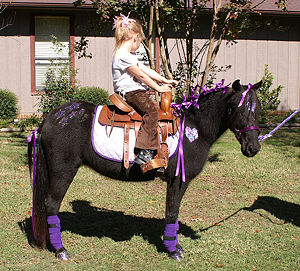AY Honors/Shetland
The Shetland pony is a breed of pony originating in the Shetland Islands. Shetlands range in size from a minimum height of approximately 28 inches to an official maximum height of 42 inches (10.2 hands, 107 cm) at the withers. (11.2 hands for American Shetlands) Shetland ponies have heavy coats, short legs and are considered quite intelligent. They are a very strong breed of pony, used for riding, driving, and pack purposes.
History
Shetland ponies originated in the Shetland Islands, located northeast of mainland Scotland. Small horses lived on the Shetland Islands since the Bronze Age, and while the roots of the ancient wild pony are unknown, it is believed that they are related to the ancient Scandinavian ponies; the islands were once physically connected to Scandinavia up until the end of the last Ice Age, approximately 8000 BC.Template:Fact People who lived on the islands domesticated the animal and later crossed the native stock with ponies imported by Norse settlers. Shetland ponies also were probably influenced by the Celtic Pony, brought to the islands by the Celts between 2000 and 1000 BC. The harsh climate and scarce food developed the ponies into extremely hardy animals.
Shetland ponies were first used for pulling carts, carrying peat and other items, and ploughing farmland. Then, as the Industrial Revolution increased the need for coal in the mid-19th century, thousands of Shetland ponies travelled to mainland Britain to be pit ponies, working underground hauling coal, often for their entire (often short) lives. Coal mines in the eastern United States also imported some of these animals.
The Shetland Pony Stud Book Society of the United Kingdom was started in 1890 to maintain purity and encourage high-quality animals. In 1957, the Shetland Islands Premium Stallion Scheme was formed to subsidize high-quality registered stallions to improve the breeding stock.
Uses
Today, Shetlands are used as children's riding ponies, are shown by both children and adults at horse shows in harness driving classes as well as for pleasure driving outside of the show ring. Shetlands are ridden by small children at horse shows, in riding schools and for pleasure. They are seen working in commercial settings such as fairs or carnivals to provide short rides for visitors. They are also seen at petting zoos and sometimes are used for Therapeutic horseback riding purposes. In the United Kingdom, they are also featured in the Shetland Pony Grand National, galloping around a racecourse with young jockeys.
Characteristics
Shetland Ponies are hardy and strong, in part because the breed developed in the harsh conditions of the Shetland Islands. In appearance, Shetlands have a small head, sometimes with a dished face, wide spaced eyes and small, alert ears. The original breed has a short, muscular neck, compact, stocky bodies, and short, strong legs and a shorter than normal cannon bone in relation to their size. A short broad back and deep girth are universal characteristics as is a springy stride. Shetlands have long thick manes and tails and a dense double winter coat to withstand harsh weather.

Shetlands can be almost every colour, including skewbald and piebald (called pinto in the United States), but are mainly black, chestnut, bay, brown, gray, palomino, dun, roan, cremello, and silver dapple. Registered shetlands are not leopard spotted (Appaloosa), nor do they carry the champagne gene, though these colors are sometimes seen in Shetland-sized crossbreds.
Shetland ponies are generally gentle, good-tempered, and very intelligent by nature. They make good children's ponies, but can be very opinionated or "cheeky," and, if not handled properly, can be impatient, snappy, and sometimes become uncooperative, traits often lumped under the label "stubborn" by those who fail to understand that pony behavior is influenced by the quality of human handling. Due in part to their intelligence and size, they are easily spoiled and can be very headstrong if not well-trained.
For its size, the Shetland is the strongest of all horse and pony breeds. It can pull twice its own weight under circumstances where a draft horse can only pull approximately half its own weight. Shetland ponies are found worldwide, though mainly in the UK and North America. In general, UK ponies tend to preserve more of the original characteristics of the breed and are often stockier than their American cousins.
Many ponies are long-lived, it is not unusual for a Shetland pony to live more than 30 years. Conversely, their small size also predisposes some individuals to a greater probability of heart problems than in larger animals, on occasion leading to early death. Shetland ponies, like many hardy small horse and pony breeds, can founder easily on a diet high in non-structural carbohydrates. Therefore owners must pay careful attention to nutrition, being careful to regulate feed quantity and type.
The American Shetland
The first Shetland ponies for which there are written records were imported to the United States in 1885 by Eli Elliot. These ponies provided the foundation stock for the development of the American Shetland, and were crossed with ponies of other breeds, including the Hackney pony, Welsh pony, and Harness Show Pony. The breeding of the ponies was mainly centered in Indiana, Illinois and Iowa.
In 1888, the American Shetland Pony Club was formed and now has two studbooks: Division A and Division B. Division A registers ponies with 12.5% or less outcross (non-Shetland) blood, and Division B is open to any pony with 12.5% or more outcross blood. Foundation Certification is also available for ponies from 4 generations of Division A breeding.
American Shetland Ponies are more refined than the traditional Shetland. They often have a long, thin, "hooky" neck, a more refined body, and longer legs. The breed tends to be long and narrow through the back, with broad and muscular hindquarters and high withers. The shoulder has good slope, allowing for extravagant action. These ponies are most often used for harness work and as children's ponies. They can be seen show jumping in classes for young riders, at horse shows in both Western and English riding classes, as well as many other competitive events, including gymkhana, novelty harness racing, and shown at halter.
However, the compact "classic" type of Shetland is still more prevalent in overall numbers in the USA, though such ponies are not always registered.
Standards in the USA and the UK
There are several major registries for Shetland ponies, the Shetland Pony Stud Book Society (SPSBS) based in UK, American Shetland Pony Club (ASPC), and the Shetland Pony Society of North America (SPSNA), both based in the USA. Shetland ponies registered with the SPSBS cannot be taller than 42" at maturity. ASPC Shetlands range in height from about 30"(rare) to 46" (the breed is measured in inches, not in hands). The Shetland Pony Society of North America was formed to honor the traditional Shetland Pony of island type. Any pony registered with other American, British, or Canadian registries can be cross-registered if it meets the pedigree and conformation standards of the SPSNA.
The official mascot of The Parachute Regiment is a Shetland pony named Pegasus.
See also
References and external links
Template:Commons Template:Equidae
als:Shetlandpony da:Shetlandspony de:Shetlandpony et:Šetlandi poni es:Pony de las Shetland fr:Shetland (cheval) it:Shetland (cavallo) hu:Shetlandi póni nl:Shetlandpony no:Shetlandsponni pl:Kuc szetlandzki fi:Shetlanninponi sv:Shetlandsponny




